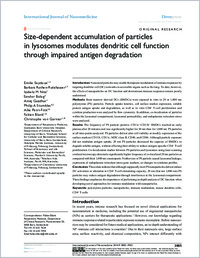Size-dependent accumulation of particles in lysosomes modulates dendritic cell function through impaired antigen degradation
- Seydoux, Emilie Department of Respiratory Medicine, Inselspital, Bern, Switzerland - Graduate School for Cellular and Biomedical Sciences, University of Bern, Switzerland
- Rothen-Rutishauser, Barbara Department of Respiratory Medicine, Inselspital, Bern, Switzerland - Adolphe Merkle Institute, University of Fribourg, Switzerland
- Nita, Izabela M Department of Respiratory Medicine, Inselspital, Bern, Switzerland
- Balog, Sandor Adolphe Merkle Institute, University of Fribourg, Switzerland
- Gazdhar, Amiq Department of Respiratory Medicine, Inselspital, Bern, Switzerland
- Stumbles, Philip A School of Veterinary and Life Sciences, Molecular and Biomedical Sciences, Murdoch University, Perth, Australia - Telethon Kids Institute, Perth, WA, Australia
- Petri-Fink, Alke Adolphe Merkle Institute, University of Fribourg, Switzerland - Department of Chemistry, University of Fribourg, Switzerland
- Blank, Fabian Department of Respiratory Medicine, Inselspital, Bern, Switzerland
- Garnier, Christophe von Department of Respiratory Medicine, Inselspital, Bern, Switzerland
-
13.08.2014
Published in:
- International Journal of Nanomedicine. - 2014, p. 3885
English
Introduction: Nanosized particles may enable therapeutic modulation of immune responses by targeting dendritic cell (DC) networks in accessible organs such as the lung. To date, however, the effects of nanoparticles on DC function and downstream immune responses remain poorly understood. Methods: Bone marrow–derived DCs (BMDCs) were exposed in vitro to 20 or 1,000 nm polystyrene (PS) particles. Particle uptake kinetics, cell surface marker expression, soluble protein antigen uptake and degradation, as well as in vitro CD4⁺ T-cell proliferation and cytokine production were analyzed by flow cytometry. In addition, co-localization of particles within the lysosomal compartment, lysosomal permeability, and endoplasmic reticulum stress were analyzed. Results: The frequency of PS particle–positive CD11c⁺/CD11b⁺ BMDCs reached an early plateau after 20 minutes and was significantly higher for 20 nm than for 1,000 nm PS particles at all time-points analyzed. PS particles did not alter cell viability or modify expression of the surface markers CD11b, CD11c, MHC class II, CD40, and CD86. Although particle exposure did not modulate antigen uptake, 20 nm PS particles decreased the capacity of BMDCs to degrade soluble antigen, without affecting their ability to induce antigen-specific CD4⁺ T-cell proliferation. Co-localization studies between PS particles and lysosomes using laser scanning confocal microscopy detected a significantly higher frequency of co-localized 20 nm particles as compared with their 1,000 nm counterparts. Neither size of PS particle caused lysosomal leakage, expression of endoplasmic reticulum stress gene markers, or changes in cytokines profiles. Conclusion: These data indicate that although supposedly inert PS nanoparticles did not induce DC activation or alteration in CD4⁺ T-cell stimulating capacity, 20 nm (but not 1,000 nm) PS particles may reduce antigen degradation through interference in the lysosomal compartment. These findings emphasize the importance of performing in-depth analysis of DC function when developing novel approaches for immune modulation with nanoparticles.
- Faculty
- Faculté des sciences et de médecine
- Department
- Département de Chimie
- Language
-
- English
- Classification
- Chemistry
- License
-
License undefined
- Identifiers
-
- RERO DOC 211397
- DOI 10.2147/IJN.S64353
- Persistent URL
- https://folia.unifr.ch/unifr/documents/303585
Statistics
Document views: 130
File downloads:
- pdf: 156
